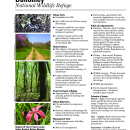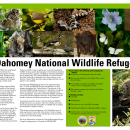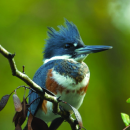Visit Us
Dahomey NWR offers opportunities to hunt, fish, birdwatch, hike, and enjoy the outdoors. The refuge is open from sunrise to sunset. During hunting season, hunters may enter the refuge two hours before sunrise and must exit the refuge no later than two hours after sunset.
All hunters and anglers should read and follow the current Hunting and Fishing Regulations and complete a harvest report card. Report cards are available at all refuge kiosks.
All visitors must wear at least 500 square inches of visible fluorescent orange above the waistline during all hunting seasons. See Hunting and Fishing Regulations for exceptions.
Directions:
To Visitor Center: The refuge lies north and south of Highway 446. Refuge headquarters are located on the north side of Highway 446, eleven miles west of Highway 61 and four miles east of Highway 1. This building is not currently staffed.
To Administration Office: The refuge is administered by the North Mississippi National Wildlife Refuges Complex, which is located at 2776 Sunset Drive, Grenada, MS 38901. From I-55, take exit 206 for Grenada. Head west on Highway 8 and the office is approximately one mile on the north side of the highway.
- From Cleveland: From the intersection of Highways 8 and 61, go south on Highway 61 approximately 3 miles. Turn right onto Highway 446. Proceed west 10.5 miles. The headquarters will be on your right.
- From Greenville: From the intersection of Highways 1 and 82, go north on Highway 1 24.5 miles. Turn right onto Highway 446. Proceed east approximately 4.6 miles. The headquarters will be on your left.
Related Documents
Other Facilities in the Complex
In 1989, the North Mississippi Refuges Complex was established to manage U.S. Fish and Wildlife Service lands in the northern twenty-six counties of Mississippi. With its headquarters in Grenada, the Complex is responsible for the management of Coldwater River, Dahomey and Tallahatchie National Wildlife Refuges, plus smaller fee-title properties and floodplain and conservation easements. The habitat consists of bottomland hardwoods, early successional reforestation areas, agricultural fields, and moist soil units.





